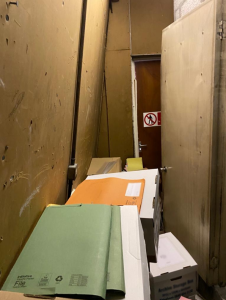Do your emergency escape routes double up as extra storage?

Article 14 of the Regulatory Reform (Fire Safety) Order 2005 explains that the responsible person must ensure that “routes to emergency exits from premises and the exits themselves are kept clear at all times” and that “emergency routes and exits must lead as directly as possible to a place of safety” Summarising, this means that the entire escape route must always remain clear and unobstructed, and the distance people must go to escape must be as short as possible.
When you perform your Risk Assessments you should pay particular attention to your escape routes; the ideal route of escape would probably involve one sterile (no objects) wide corridor leading right to the emergency exit opening to the outside, allowing everyone to walk calmly to the muster point.
Any items stored in escape routes are seen as a hazard, but if the items are also combustible or could be an ignition source then this is a major hazard.

As with all Health & Safety, decisions should be sensible, measured, and justifiable. In the above example you can see that the escape route is completely blocked by boxes of paperwork, this is clearly an obstruction and the risk is increased further by the items being flammable and the door being wedged open!
This isn’t to say that an escape route must be completely devoid of all items – it means that if items are in a corridor these should not block or impede the movement of people escaping. For example, a drinks machine or metal lockers for storing personal belongings could be used in an escape corridor as long as the remaining width of the corridor is sufficient for:
- the number of people using the escape
- the design and age of the building
When we’re on site, we often find that escape routes are filled with boxes which should be removed from the area and dealt with appropriately, such as:
- filed away in an alternate location in the office
- digitised and shredded
- moved to external storage
Keeping routes clear is an ongoing job – one box turns quickly into four or five and it becomes a dumping ground. Escape routes should be checked every month on average and if items keep appearing then ensure staff are notified about the risks and consequences. Alongside this, staff should all have appropriate Fire Safety Awareness training and a sufficient number of Fire Marshals should be trained to manage evacuations.
Need a hand with your Risk Assessments and management of risks? We’re here to reduce your worry about Health & Safety so get in touch with us today to see how we can help.
Our content is correct at the date of publishing, but should not be taken as legal advice, and our articles don’t replace Risk Assessments. Armour will not be held accountable for any legal actions the reader may take.

